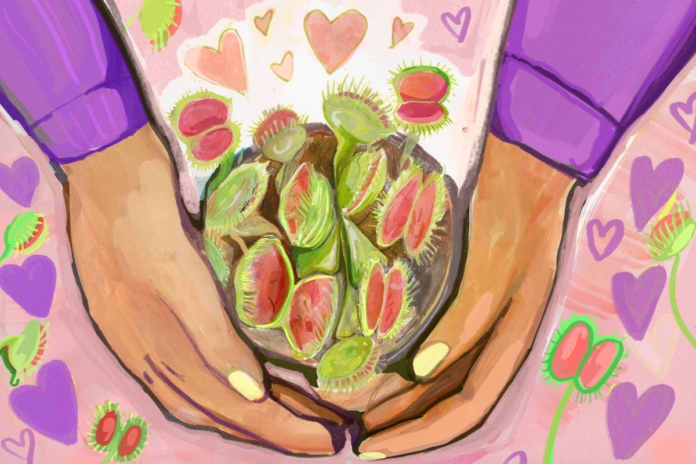
Pets are a common companion for people of all ages, and come in a variety of forms. I myself had seven birds and two parrots at home. Others might have fluffy dogs, lovable cats, adorable hamsters, amazing turtles … and carnivorous plants, right?
While they might not be the first organisms you turn uk best essays.org to when looking into adopting a new pet, something must be said for the link between meat-eating and the ability to be … pet-ed. If you’re interested in perhaps taking in one of these unusual plants, Venus flytraps in particular might be your most accessible bet when entering the world of exotic plant ownership.
A brief introduction to carnivorous plants
Carnivorous plants, also known as meat-eating plants, were described by Charles Darwin as “the most wonderful plants of the world.” These plants are found all over the world in various climates, and can differ in how predatory they actually are (i.e. how many levels of the food chain they get their food from).
The Venus flytrap is, in North America at least, one of the first carnivorous plants most of us are exposed to, and are native to the warm and humid habitats of North and South Carolina in the United States.
Venus flytraps live in acidic soil and are often found growing in forests of several southeastern states outside of the Carolinas, but have become more vulnerable due to overcollection, habitat destruction, and human suppression of natural wildfires (preventing increased growth as excess plantlife is not ‘burnt out.’)
What’s in a meal?
Likely the most interesting aspect of the Venus flytrap is how it catches its prey.
The Venus flytrap rests with its “jaws” (which are actually just leaves) open, exposing all the small trigger hairs that can sense anything that lands on them, no matter how small. If a fly, for example, lands on the trigger hairs (to which they are attracted by the plant’s sickeningly-sweet excretions), the leaves immediately essays services reviews.com shut and the fly is stuck between them both with no room for escape. Enzymes are then released to break down the fly, and the plant absorbs whatever useful nutrients comes out of its prey.
After five to 12 days, the Venus flytrap’s “mouth” opens and releases the waste left from digesting its juicy insect. While the plants are always in the position to catch something else, they can live without a meal for a few months before catching another insect to eat.
However, the Venus flytrap doesn’t live solely off of bugs. As mentioned earlier, these plants live in acidic soil, meaning they cannot get all the nutrients that they need through the soil alone. While the plant performs photosynthesis in order to get the majority of its core nutrients, the Venus flytrap developed the ability to eat insects in order to obtain nutrients it cannot get from either the sun or acidic soil, like nitrogen and phosphorus.
Why aren’t all plants this hardcore?
The question remains: if eating bugs worked for the Venus flytrap, why aren’t all plants carnivorous? This goes back to evolution, or more specifically, the common ancestor of all carnivorous plants that existed about 70 million years ago.
A group of researchers in Germany conducted a study looking into three common meat-eating plants from the Droseraceae family—the flowering branch of the carnivorous plant family. These researchers found the common ancestor for these three plants had its genome duplicated—meaning it developed an extra set of genes, and thus had more opportunity for adaptation.
As a result, the genes that would normally express leaves and roots were “free” to interact with their environments, meaning some were able to code for the gene required for “trapping leaves.”
In accordance with the survival of the fittest theory, these kinds of mechanisms and structural changes allowed some plants to adapt to profound changes in their environments, such as the increased acidification of soil. These changes included better trapping-leaf structures, as well as roots that produced enzymes to help with the digestion of prey.
OK, but how do I get one to be my pet?
Venus flytraps aren’t actually that hard to nurture compared to other plants. After purchasing a Venus flytrap from your local speciality plant retailer, in order to ensure your little green friend continues to grow, one must ensure:
- The plant gets at least four hours of direct sunlight each day. If possible, it’s best practice to grow the Venus flytrap outside so they are able to get enough of this direct sunlight—while also reserving the possibility for them to catch their own food, like flies and insects.
- The plant is watered regularly through either rain or filtered water (which works best due to the lack of minerals). Make sure the soil is fully wet after it’s watered, and only water it again when the soil becomes almost dry.
- The plant is sowed in a low-nutrient soil. The most common recipe is a 50/50 mixture of peat moss and silica sand.
Whether or not you decide to invite one of these strange little plants into your home, hopefully you learned something new about this often overlooked but friendly fauna.
Featured graphic by Sara Mizannojehdehi.



![Here’s how your favorite media platforms shape your world view without you realizing it Advertising revenue and subscriptions are the main source of income for news outlets. [Graphic by Sara Mizannojehdehi]](https://charlatan.ca/wp-content/uploads/2021/07/11BE7ADB-1CC8-46E8-ADB4-568B3C7F1265-218x150.jpeg)

